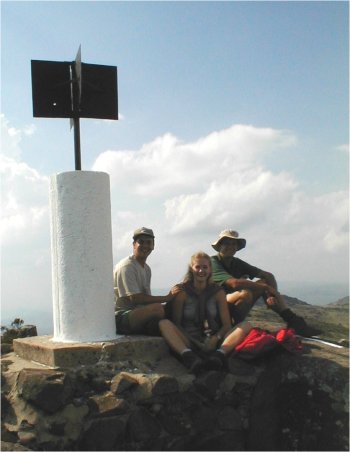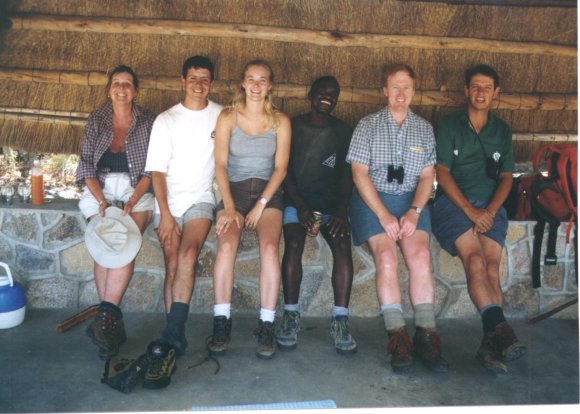
Home
Mission
Overview of Project
Project Staff
Sponsors
Achievements
Checking, Illustrations
Upcoming Activities
Id and Species Lists
Protea Information
Protea Gallery
Growing Proteas
Interim Dist. Maps
Publications
Afrikaanse Inligting
![]()
Protea Atlas Project Visits Zimbabwe - November 1999
The Protea Atlas Project recently visited Zimbabwe. The tour took the Project from Beit Bridge - Harare - Nyanga Mountains - Mutare - Chimanimani Mountains - Harare - Bulawayo - Beit Bridge and back in to South Africa. The South African / British connection comprised Tony Rebelo, Val Charlton, Gail Reeves, Mervyn Lotter and Nigel Forshaw.
The object of the tour was to
- Meet Zimbabweans and get them interested in atlassing the proteas of Zimbabwe and
- The collection of scientific data.
Contact was made with the Zimbabwe Tree Society, the Harare Herbarium and many very kind local Zimbabweans interested in their flora.
Photographs of the following proteas were taken:
- Manica Sugarbush - Protea caffra gazensis
- Sickle-leaf Sugarbush - Protea petiolaris elegans
- African Sugarbush - Protea gaguedi
- Dwarf Savanna Sugarbush - Protea welwitschii
- Wentzel's Sugabush - Protea wentzeliana
- Escarpment Pincushion - Leucospermum saxosum
I joined up with the Protea Atlas team of Tony Rebelo, Val Charlton, Mervyn Lotter and Gail Reeves in Harare. They had already driven the 4X4 up from Cape Town.
We were soon atlassing in the Norton district near Harare on the farm Serui Source where we were very kindly hosted by Jim and Ann Sinclair. Here we saw African Sugarbush Pr gaguedi, Woodland Sugarbush Pr angolensis divaricata, Dwarf Savanna Sugarbush Pr welwitschii and Broad-leaf Beechwood Fa rochetiana. There were also some hybrids thrown in just to confuse us - but only briefly - of course. The Harare herbarium staff and the Tree Society went on a short walk and were shown the intricacies of Protea Atlassing. There is a most striking difference to walking in the Fynbos of the Western Cape and walking in Zimbabwe. Most of Zimbabwe is either grassland or woodland.
The next leg of the trip was the drive from Harare to the Nyanga Mountains. It wasn't too soon before Mervyn piped up "Stop – Faurea saligna". We duly stopped and sure enough it was the Transvaal Beechwood. For the untuned eye, it is very easy to walk right past a Beechwood without noticing it. What is equally amazing, is that when once the eye is tuned in to these plants they jump out at you. After having never seen Fa saligna at Kirstenbosch I have now discovered that they are actually frequent in the garden. Still on the road to Nyanga, we added Manica Sugarbush Pr caffra gazensis and Woodland Sugarbush Pr angolensis angolensis to our Zimbabwe species list. Pr ango a is a dwarf version of Pr ango divaricata. Its flowers are about 500 mm to 1 m off above the ground whereas Pr ango d grows into a tree. On arriving in the Nyanga Mountains, Mervyn who has a very sharp eye indeed, spotted Sickle-leaf Sugarbush Pr petiolaris. This Sugarbush has the unmistakable feature of leaves that droop. What a day – we managed 150 SRS on roadside atlassing – surely a record!
In the Nyanga mountains we were very kindly hosted by Bob Burrell. He showed us a vast plain of Pr welwitschii and Pr caffra gazensis above his property in amongst granite boulders and slopes.
Our next target was Mount Inyangani which is the highest peak in Zimbabwe and where Drakensberg Sugarbush Pr dracomontana is known from. After a slow drive to the base of the peak, atlassing all the way of course, Tony, Gail, Mervyn and I set off for the peak. On the way up we soon came across Inyanga Sugarbush Pr asymmetrica as well as a Pr caffra gazensis X asymmetrica hybrid. We soon conquered the peak at over 2500 m and celebrated Gail's birthday with just a tot of drambuie. There is a lot of superstition about Mount Inyangani. People have gone up to the peak and never returned. There are certain "do's" and "don'ts". One don't, is that you should never point at the peak. One do, related to female dress etiquette, was not carried out and as a result Gail sprained her ankle 20 m below Mount Inyangani peak. Don't worry, we all got down safely. Meanwhile Val instructed the Zimbabweans on how to atlas, but she too got to the top of Zimbabwe.
We then drove from the Nyanga Mountains to Mutare and headed south to the village Chimanimani, via the Scenic Route. This is in eastern Zimbabwe. Up until then, we thought that Pr petiolaris was rare but in fact it is all over the place on this route. We also saw lots of Fa saligna, Fa rochetiana, Pr caffra gazensis and Pr welwitschii. A hybrid of Fa rochetiana X saligna was found on the Scenic Route to add to our list of many Zimbabwean hybrids.
In Chimanimani we were very kindly hosted, by Tempie and Doug van der Ruit. Now for some different proteas! After being on granite for the whole trip we moved onto the sandstone of the Chimanimani Mountains and immediately started seeing different proteas. Escarpment Pincushion Ls saxosum grows on sandstone whereas the Chimanimani Sugarbush Pr enervis was found on the shallow quartzitic soils on the Bundi plain. Val, Darell Plowes and I then headed for Peza peak at over 2400 m. We found two populations of Wentzel’s Sugarbush Pr wentzeliana on sandstone and were lucky enough to see one plant flowering. Our second day in the Chimanimani mountains at The Corner saw no new species to the Protea Atlas team but I was fortunate enough to see Manica Beechwood Fa rubriflora for the first time, and even managed a sneak plot in Mozambique.
The show then moved to Bulawayo where we were very kindly hosted by Jonathan Timberlake and Mary Friends. The Bulawayo area has just two species of proteas, being Fa saligna and Pr gaguedi. Val gave the Bulawayo Tree Society a crash course in how to atlas.
The only species that I did not see was the River Beechwood Fa delevoyi. It was found at the start of the Zimbabwe trip near the Harare airport but alas I did not see this species as I was in a Boeing 767 at 37 000ft.
The Zimbabwe Protea Atlas trip was one that I thoroughly enjoyed. I will remember the trip for a long time. The people are great! There are lots of new species for the ‘Western Capers’ to bag. Perhaps Zimbabwe is the last paradise (well almost) for mercenaries hunting to bag new species. Thanks to Val for organizing the logistics. Thanks to Tony, Mervyn and Gail for a great trip.
Nigel Forshaw
Zimbabwe Trip and Protea Relations
My parents consider it a mission to visit me in London from Birmingham (a two-hour pop down the motorway), the next time they mutter such sentiments I’m going to pull out a map of southern Africa and enlighten them. Try Cape Town – Harare … now there’s a mission!
So up until the time of this trip Zimbabwe was previously unchartered Protea Atlas territory. My number one priority was to collect leaf material from as many summer rainfall species as possible from that part of the world for the Protea phylogeny. When I get home I can then look at their DNA sequences to answer the question of where they fit into the picture of protea’s evolutionary history. During the course of our trip I collected Pr ango angolensis, ango divaricata, enervis, neocrinita, inyanganiensis, assymetrica, petiolaris and Fa rubriflora. The relationships between summer and winter rainfall groups is one of the key questions, and by including as many species as possible from both regions we aim to shed some light upon how the genus may have radiated or evolved in Africa.
The summer rainfall/tropical African and winter rainfall/Cape species have been taxonomically dealt with by two authorities with somewhat different philosophical and practical approaches to species’ delimitations and taxonomy. Despite the fact that there are substantially fewer Protea species represented in tropical Africa than the Cape Region, their taxonomy is far from clear cut. Within species, morphological plasticity is great, making clear-cut boundaries to define where one species ends and the other begins difficult to formulate. Added to this, the prevalence of hybrids in summer rainfall areas is overwhelming, which further complicates the issue.
In reality the answer to the question ‘when is a species not a good species’ very much comes down to a matter of opinion. The taxonomic status that should be assigned to the diversity that we observe is thus a hotly contested issue where very few generalizations can be made. Our treatment of Pr caffra is an ideal case in point. In Zimbabwe and the Northern Transvaal I collected material from Pr caffra subsp. rhodantha and Pr caffra subsp. gazensis (that have in previous taxonomic treatments have been described as separate species from Pr caffra subsp. caffra) with the intention of using their DNA sequences to ascertain whether the morphological diversity is in any way reflected in genetic diversity. Another example is that of Pr dracomontana subsp. inyanganiensis, found on the highest peak in Zimbabwe. This too has been described as a separate species from dracomontana in the Drakensberg, but is it really a good species? Really the best way to get to grips with these problems would be to look at ‘genetic fingerprints’ of the species complexes across the whole of their geographical ranges. This would allow us to look at genetic diversity at a scale that I probably will not be able to detect using DNA sequences. However, in the meantime I will be very interested to see whether these closely related species exhibit similar levels of genetic diversity to analogous species complexes in the Cape. The phylogeny will not give absolute answers as to where species boundaries should be drawn but we may be able to draw comparisons and look at relative rates of genetic divergence among summer and winter rainfall groups.
So, at this juncture there are more questions relating to the summer rainfall species than there are answers. Certainly molecular systematics does not hold the answer to life, the universe and everything, but hopefully the DNA phylogeny will provide additional evidence to fuel the debate. Once again, watch this space……
Gail Reeves
Atlassing at Serui Source, Norton near Harare

Tony Rebelo (in purple T-shirt) instructs the Tree Society and Harare Herbarium staff on how to atlas
Tony Rebelo and Gail Reeves in the Nyanga Mountains

Gail Reeves collected leaves from this Manica Sugarbush - Protea caffra gazensis plant (permit obtained from the Harare Herbarium) for DNA analysis for her PhD
Pondering over atlassing in a Grassland

Note the Dwarf Savanna Sugarbush - Protea welwitschii in the background
Mount Inyangani at 9500ft conquered by the Protea Atlas Project

Mervyn Lotter, Gail Reeves and Tony Rebelo. Val Charlton and Nigel Forshaw also got there!
The interest in getting to the peak was not only the peak but also seeing Protea dracomontana - Drakensberg Sugarbush (Protea inyanganiensis)
Atlassing near Bulawayo

Gail Reeves, Tony Rebelo and Mervyn Lotter

Val Charlton, Mervyn Lotter, Gail Reeves, Surrender, Nigel Forshaw, Tony Rebelo
And finally, friendships were renewed

Gail Reeves and Mervyn Lotter
Back PAN 45